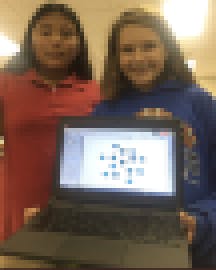When Dr. Brooke Morgan walks into a classroom at Talladega County Schools, she's met with the buzz of students asking questions, collaborating, problem-solving, and building. "I call it productive noise," says the Coordinator of Innovative Learning for the district.
It's the engaged clatter of students building the computational thinking skills that will set them up for success in the workplace (and hopefully help break the cycle of poverty many students in the district face).
Computational thinking is an approach to problem-solving where students organize and analyze data, create algorithms, and then develop and use models and simulations to test theories and ideas. It’s an approach that students can use in any subject (yes, even English Language Arts).

But while the Alabama district is a member of the League of Innovative Schools and leads the state in STEM and STEAM (seven of the district’s 17 schools have earned the prestigious STEM certification from Cognia), computational thinking is new to most students and teachers. That meant professional development around the concept of computational thinking and how to teach those specific skills were essential.
Enter micro-credentials—digital certifications that verify an individual’s competence in a specific skill or set of skills. With their sharp focus and support in breaking down complex skills, Dr. Morgan says they were the perfect approach to PD for computational thinking.
EdSurge asked Morgan to share why computational thinking skills are essential to student success and why focusing on micro-credentials was crucial to ensuring they're taught in Talladega classrooms.
EdSurge: Why are computational thinking skills such a key ingredient in your efforts to support students?
Morgan: Research tells us problem-solving and computing skills are the most sought-after qualifications in the job market today. So with seventy-one percent of students at Talladega County Schools eligible for free and reduced lunch, a key indicator of low socioeconomic levels, we're focused on building these skills district-wide, from K to 12 with all students.
We want to provide equitable learning opportunities and break the cycle of poverty in our district.
Why were micro-credentials the right PD initiative to help bring computational thinking to classrooms?

We were already working with Digital Promise on the Computational Thinking Pathways Challenge Collaborative. And with the micro-credential stacks that Digital Promise offers, it just made sense.
Often, when we do professional development, we find teachers come to the meetings engaged, and are even planning great things. But teachers are busy and have a lot of responsibilities, so the follow-through isn't always there—especially if they aren't confident in a concept.
Micro-credentials, Macro rewards: Learn how micro-credentials empower educators to drive their professional learning.
The Digital Promise micro-credentials focus on a single competency, are backed by research and require teachers to submit evidence of how they are applying their learning in the classroom.
So there's accountability with the teachers. Teachers can show they're taking what they've learned and actually doing something with it, successfully implementing it into teaching and learning.
We also have a strong focus on STEM and STEAM in our schools and work to meet Next Generation Science Standards. And since five of the eight NGSS essential practices are basically computational thinking, including data collection, analyzing data, and building models, it was a perfect fit.
What kinds of teacher success are you seeing with micro-credentials?
Last year, a group of teachers worked on a micro-credential that focused on planning a lesson that involved two computational thinking skills: data collection and analysis.
We had a 100% success rate when teachers applied for that micro-credential. And I think it was because we did it with a TLC (Teacher Learning Community) model. Teachers brainstormed lesson ideas in a round table format. After they taught the lesson and had the evidence, we came back together to review their submission with the group, get feedback, and make tweaks before submitting it.

And our teachers are proud; our Twitter feed stays really hot because they want to share these lessons they're doing. You can see evidence on their classroom walls where they've been talking about these competencies. It's genuinely embedded in their everyday instruction now. And these teacher leaders are taking their learning back to their schools so other teachers can start earning micro-credentials in their content areas with these competencies.
How has using micro-credentials impacted student learning?
Students are much more engaged, and they have a common vocabulary and understanding around problem-solving.
Students are collecting and analyzing data in science and social studies. They're even doing algorithmic thinking in English Language Arts classrooms through the writing process.
When students are given those opportunities daily in multiple content areas, they are just immersed in the language and in the concepts. What the teachers are seeing is students are becoming more confident in problem-solving.
We know critical thinking and problem-solving are essential skills for our students to have. But teachers often don't feel confident in teaching students how to think. The computational thinking competencies provide a framework and put words and vocabulary to what we're trying to do.
Get started with micro-credentials today with the Digital Promise Micro-credentials Platform.
Teachers feel more confident that they are preparing their students. It's easy to say, "Oh, we're going to work on problem-solving today." But unless you have an organized and systematic approach to solving a problem, it's hard to measure whether or not a student is being successful with that strategy.
What should other schools or districts know if they are interested in encouraging teachers to use micro-credentials?
You need to be intentional about choosing micro-credentials that match your current professional development and learning goals. Also, show teachers how working through that process helps enhance their instruction and the learning of the student.
That's the catalyst for getting them to own it and to seek micro-credentials to personalize their own competencies and build their resume. In the beginning, work through a couple with the teachers, and give them support and opportunities to collaborate with others.



